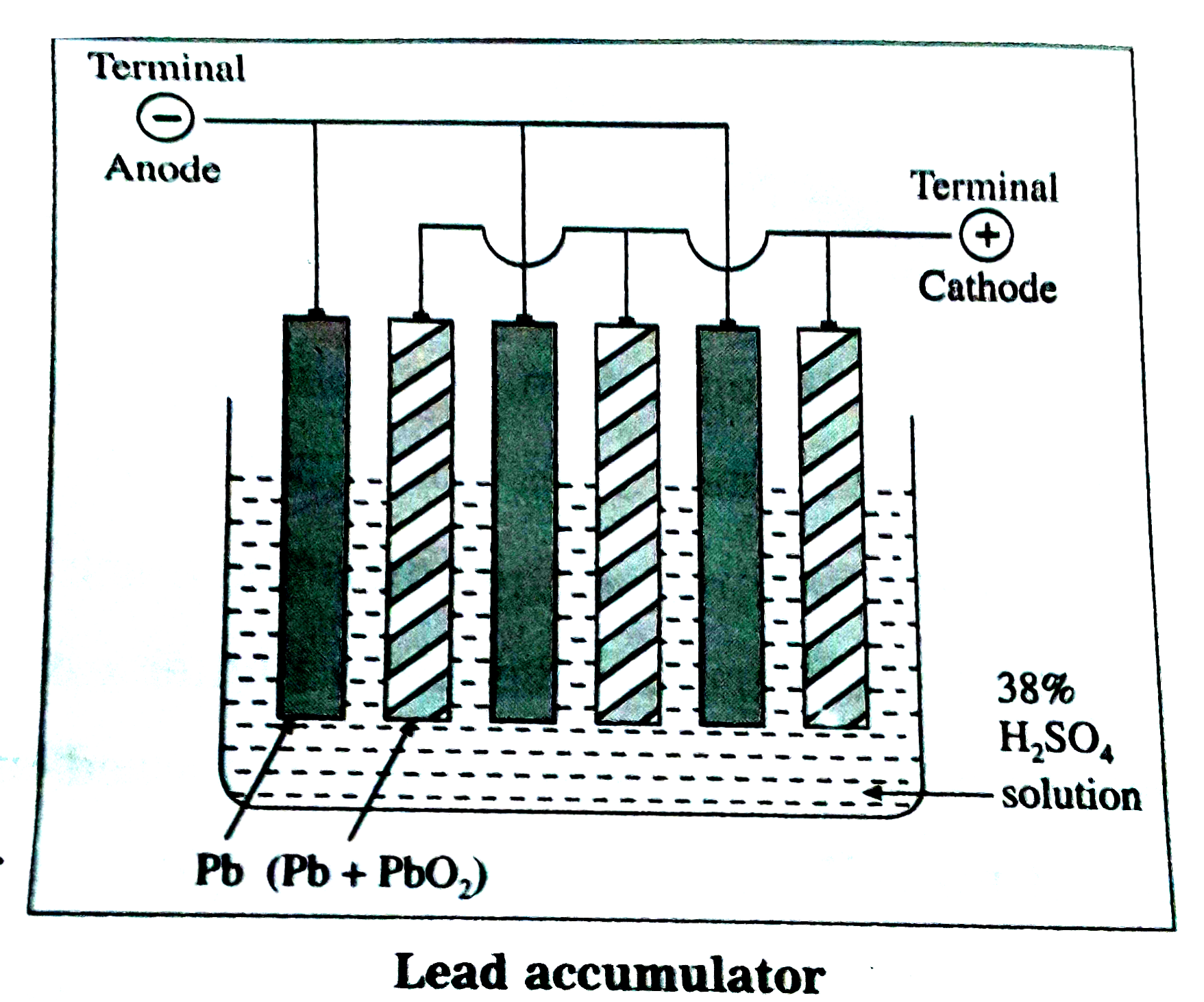Describe the construction and working of lead accumulator (lead storage cell).
Text Solution
(A) Principle :
(1) The lead accumulator is a secondary electrochemical cell and it is also called lead accumulator or lead storage battery.
(2) It is a reversible cell.
(B) Construction : In a lead accumulator, the negative terminal (anode) is made up of lead sheets packed with spongy lead, while the positive terminal (cathode) is made up of lead grids packed with PbO2 .
Sulphuric acid of about 38% strength (%w/w) or specific gravity 1.28 or 4.963 molar is the electrolyte in which the lead sheets and lead grids are dipped. The positive terminal and negative terminal are alternatively arranged in the electrolyte and are separately interconnected .

(C ) Representation of lead accumulator :
−Pb(s)(Anode)∣∣PbSO4(s)∣∣H2SO4(aq)38%∣∣PbSO4(s)∣∣PbO2(s)(Cathode)∣Pb+
(D) Working of a lead accumulator :
(1) Discharging : When the electric current is withdrawn from lead accumulator, the following reactions take place :
Oxidation at the -ve electrode or anode :
Pb(s)→Pb2+(aq)+2e−(oxidation)Pb2+(aq)+SO2−4(aq)→PbSO4(s)(precipitation)Pb(s)+SO2−4(aq)→PbSO4(s)+2e−(overall oxidation at anode)
Reduction at the +ve electrode or cathode :
PbO2(s)+4H+(aq)+2e−→Pb2+(aq)+2H2O(l)(reduction)Pb2+(aq)+SO2−4(aq)→PbSO4(s)(precipitation)PbO2(s)+4H+(aq)+SO2−4aq+2e−→PbSO4(s)+2H2O(l)(overall oxidation at anode)
(2) Net cell reaction :
(i) Thus, the overall cell reaction during discharging is
Pb(s)+PbO2(s)+4H+(aq)2SO2−4(aq)→2PbSO4(s)+2H2O(l) OR
Pb(s)+PbO2(s)+2H2SO4(aq)→2PbSO4(s)+2H2O(l)
During the operation, the concentration of H2SO4 decreases and specific gravity decreases from 1.28 to 1.17.
(ii) Recharging of the cell : The discharged battery is connected to external electric source and a higher external potential is applied across its electrodes and current is passed in reverse direction. As a result the cell reaction gets reversed generating H2SO4.
Reduction at the -ve electrode or cathode :
PbSO4(s)+2e−→Pb(s)+SO2−4(aq)
Oxidation at the +ve electrode or anode : -
PbSO4(s)+2H2O(l)→PbO2(s)+4H+(aq)+SO2−4(aq)+2e−
The net reaction during charging is
2PbSO4(s)+2H2O(l)→Pb(s)+PbO2(s)+4H+(aq)+2SO−4(aq) OR
2PbSO4(s)+2H2O→Pb(s)+PbO2(s)+2H2SO4(aq)
(E) Applications :
(1) It is used a source of d.c. electric supply.
(2) It is used in automobile in ignition circuits and lighting the head lights by connecting 6 batteries giving 12 V potential .
(3) It is also used in invertors.
|
Similar Questions
Knowledge Check
The lead accumulator is
Aprimary , reversible voltaic cellBsecondary , reversible voltaic cellCprimary , irreversible voltaic cellDsecondary, irreversible cellDuring charging of lead accumulator
Aelectrolysis of PbSO4 takes place and Pb and PbO2 are depositedBPb and PbO2 are depositedCspecific gravity of H2SO4 remains sameDspecific gravity of H2SO4 decreasesLead accumulator is a secondary storage cell because
Ait is an irreversible cellBelectrical energy is previously stored in it from an external sourceCelectrolysis occurs in itDit involves H2SO4 solution
